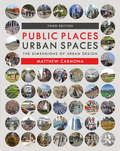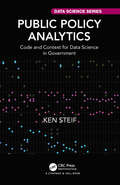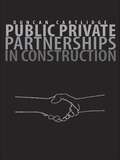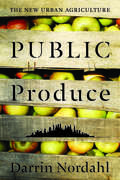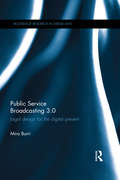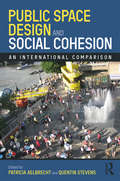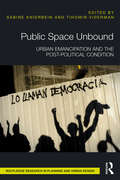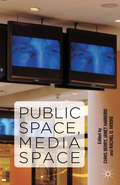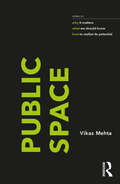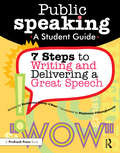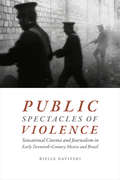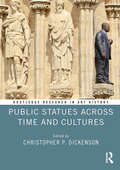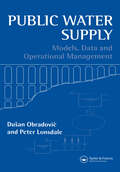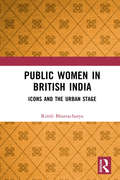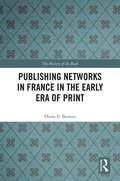- Table View
- List View
Public Places Urban Spaces: The Dimensions of Urban Design
by Matthew CarmonaPublic Places Urban Spaces provides a comprehensive overview of the principles, theory and practices of urban design for those new to the subject and for those requiring a clear and systematic guide. In this new edition the book has been extensively revised and restructured. Carmona advances the idea of urban design as a continuous process of shaping places, fashioned in turn by shifting global, local and power contexts. At the heart of the book are eight key dimensions of urban design theory and practice—temporal, perceptual, morphological, visual, social, functional—and two new process dimensions—design governance and place production. This extensively updated and revised third edition is more international in its scope and coverage, incorporating new thinking on technological impact, climate change adaptation, strategies for urban decline, cultural and social diversity, place value, healthy cities and more, all illustrated with nearly 1,000 carefully chosen images. Public Places Urban Spaces is a classic urban design text, and everyone in the field should own a copy.
Public Policy Analytics: Code and Context for Data Science in Government (Chapman & Hall/CRC Data Science Series)
by Ken SteifPublic Policy Analytics: Code & Context for Data Science in Government teaches readers how to address complex public policy problems with data and analytics using reproducible methods in R. Each of the eight chapters provides a detailed case study, showing readers: how to develop exploratory indicators; understand ‘spatial process’ and develop spatial analytics; how to develop ‘useful’ predictive analytics; how to convey these outputs to non-technical decision-makers through the medium of data visualization; and why, ultimately, data science and ‘Planning’ are one and the same. A graduate-level introduction to data science, this book will appeal to researchers and data scientists at the intersection of data analytics and public policy, as well as readers who wish to understand how algorithms will affect the future of government.
Public Private Partnerships in Construction
by Duncan CartlidgeCollaborative working and partnering between the public and private sectors has been fairly standard practice in some form or other for over 100 years, but it is only in recent years that it has become more prevalent. In the UK, it is little more than ten years since the most widely known Public Private Partnership (PPP), the Private Finance Initiative (PFI), was launched and yet it has already been described by some as 'the new economic paradigm.' Public Private Partnerships in Construction is an authoritative and objective source of information on PPPs, including lessons to be learnt from the past decade, as well as coverage of their spread beyond the UK to governments in areas as diverse as Cambodia and California. With its detailed presentation of current issues, illustrated with case studies, this book provides a valuable practical resource for a range of students and professionals.
Public Produce: The New Urban Agriculture
by Darrin NordahlPublic Produce makes a uniquely contemporary case not for central government intervention, but for local government involvement in shaping food policy. In what Darrin Nordahl calls "municipal agriculture," elected officials, municipal planners, local policymakers, and public space designers are turning to the abundance of land under public control (parks, plazas, streets, city squares, parking lots, as well as the grounds around libraries, schools, government offices, and even jails) to grow food. Public agencies at one time were at best indifferent about, or at worst dismissive of, food production in the city. Today, public officials recognize that food insecurity is affecting everyone, not just the inner-city poor, and that policies seeking to restructure the production and distribution of food to the tens of millions of people living in cities have immediate benefits to community-wide health and prosperity. This book profiles urban food growing efforts, illustrating that there is both a need and a desire to supplement our existing food production methods outside the city with opportunities inside the city. Each of these efforts works in concert to make fresh produce more available to the public. But each does more too: reinforcing a sense of place and building community; nourishing the needy and providing economic assistance to entrepreneurs; promoting food literacy and good health; and allowing for "serendipitous sustenance." There is much to be gained, Nordahl writes, in adding a bit of agrarianism into our urbanism.
Public Properties: Museums in Imperial Japan
by Noriko AsoIn the late nineteenth century, Japan's new Meiji government established museums to showcase a national aesthetic heritage. Inspired by Western museums and expositions, these institutions were introduced by government officials hoping to spur industrialization and self-disciplined public behavior, and to cultivate an "imperial public" loyal to the emperor. Japan's network of museums expanded along with its colonies. By the mid-1930s, the Japanese museum system had established or absorbed institutions in Taiwan, Korea, Sakhalin, and Manchuria. Not surprising, colonial subjects' views of Japanese imperialism differed from those promulgated by the Japanese state. Meanwhile, in Japan, philanthropic and commercial museums were expanding, revising, and even questioning the state-sanctioned aesthetic canon. Public Properties describes how museums in Japan and its empire contributed to the reimagining of state and society during the imperial era, despite vigorous disagreements about what was to be displayed, how, and by whom it was to be seen.
Public Service Broadcasting 3.0: Legal Design for the Digital Present (Routledge Research in Media Law #8)
by Mira BurriThe digital media environment is characterized by an abundance and diversity of content, a multiplicity of platforms, new modes of content production, distribution and access, and changed patterns of consumer and business behaviour. This has challenged the traditional model of public service broadcasting (PSB) in diverse ways. This book explores whether and how PSB should adapt to reflect the conditions of the digital media space so that it can effectively and efficiently continue to serve its public mandate. Drawing on literature on media governance in media and communication science, public international law as well as discussions on cyberlaw, Mira Burri maps and critically analyses existing policy and scholarly debates on PSB transformation. She challenges some of conventional rationales for reform, identifies new ones, as well as exposes the limitations placed upon existing and future policy solutions by global media governance arrangements, especially in the fields of trade, copyright and Internet governance. The book goes on to advance a future-oriented model of Public Service Media, which is capable of matching an environment of technological and of governance complexity. As a work that explores how public interest objectives can be pursued efficiently and sustainably in the digital media ecology, this book will be of great interest and use to students and researchers in media law, information technology law, and broadcast media studies, as well as to policy-makers.
Public Space Design and Social Cohesion: An International Comparison
by Patricia Aelbrecht Quentin StevensSocial cohesion is often perceived as being under threat from the increasing cultural and economic differences in contemporary cities and the increasing intensity of urban life. Public space, in its role as the main stage for social interactions between strangers, clearly plays a role in facilitating or limiting opportunities for social cohesion. But what exactly is social cohesion, how is it experienced in the public realm, and what role can the design of city spaces have in supporting or promoting it? There are significant knowledge gaps between the social sciences and design disciplines and between academia and practice, and thus a dispersed knowledge base that currently lacks nuanced insight into how urban design contributes to social integration or segregation. This book brings together scholarly knowledge at the intersection of public space design and social cohesion. It is based on original scholarly research and a depth of urban design practice, and analyses case studies from a variety of cities and cultures across the Global North and Global South. Its interdisciplinary, cross-cultural analysis will be of interest to academics, students, policymakers and practitioners engaged with a range of subject areas, including urban design, urban planning, architecture, landscape, cultural studies, human geography, social policy, sociology and anthropology. It will also have significant appeal to a wider non-academic readership, given its topical subject matter.
Public Space Reader
by Mitrašinović Miodrag Mehta VikasRecent global appropriations of public spaces through urban activism, public uprising, and political protest have brought back democratic values, beliefs, and practices that have been historically associated with cities. Given the aggressive commodification of public re- sources, public space is critically important due to its capacity to enable forms of public dis- course and social practice which are fundamental for the well-being of democratic societies. Public Space Reader brings together public space scholarship by a cross-disciplinary group of academics and specialists whose essays consider fundamental questions: What is public space and how does it manifest larger cultural, social, and political processes? How are public spaces designed, socially and materially produced, and managed? How does this impact the nature and character of public experience? What roles does it play in the struggles for the just city, and the Right to The City? What critical participatory approaches can be employed to create inclusive public spaces that respond to the diverse needs, desires, and aspirations of individuals and communities alike? What are the critical global and comparative perspectives on public space that can enable further scholarly and professional work? And, what are the futures of public space in the face of global pandemics, such as COVID-19? The readers of this volume will be rewarded with an impressive array of perspectives that are bound to expand critical understanding of public space.
Public Space Unbound: Urban Emancipation and the Post-Political Condition
by Sabine Knierbein Tihomir VidermanThrough an exploration of emancipation in recent processes of capitalist urbanization, this book argues the political is enacted through the everyday practices of publics producing space. This suggests democracy is a spatial practice rather than an abstract professional field organized by institutions, politicians and movements. Public Space Unbound brings together a cross-disciplinary group of scholars to examine spaces, conditions and circumstances in which emancipatory practices impact the everyday life of citizens. We ask: How do emancipatory practices relate with public space under ‘post-political conditions’? In a time when democracy, solidarity and utopias are in crisis, we argue that productive emancipatory claims already exist in the lived space of everyday life rather than in the expectation of urban revolution and future progress.
Public Space and Relational Perspectives: New Challenges for Architecture and Planning
by Sabine Knierbein Chiara TornaghiTraditional approaches to understand space tend to view public space mainly as a shell or container, focussing on its morphological structures and functional uses. That way, its ever-changing meanings, contested or challenged uses have been largely ignored, as well as the contextual and on-going dynamics between social actors, their cultures, and struggles. The key role of space in enabling spatial opportunities for social action, the fluidity of its social meaning and the changing degree of "publicness" of a space remain unexplored fields of academic inquiry and professional practice. Public Space and Relational Perspectives offers a different understanding of public spaces in the city. The aim of the book is to (re)introduce the lived experiences in public life into the teaching curricula of those academic disciplines which deal with public space and the built environment, such as architecture, planning and urban design, as well as the social sciences. The book presents conceptual, practical and research challenges and brings together findings from activists, practitioners and theorists. The editors provide eight educational challenges that educators can endorse when training future practitioners and researchers to accept and to engage with the social relations that unfold in and through public space. Cover image: KARO*
Public Space and the Challenges of Urban Transformation in Europe
by Sabine Knierbein Ali Madanipour Aglaée DegrosEuropean cities are changing rapidly in part due to the process of de-industrialization, European integration and economic globalization. Within those cities public spaces are the meeting place of politics and culture, social and individual territories, instrumental and expressive concerns. Public Space and the Challenges of Urban Transformation in Europe investigates how European city authorities understand and deal with their public spaces, how this interacts with market forces, social norms and cultural expectations, whether and how this relates to the needs and experiences of their citizens, exploring new strategies and innovative practices for strengthening public spaces and urban culture. These questions are explored by looking at 13 case studies from across Europe, written by active scholars in the area of public space and organized in three parts: strategies, plans and policies multiple roles of public space and everyday life in the city. This book is essential reading for students and scholars interested in the design and development of public space. The European case studies provide interesting examples and comparisons of how cities deal with their public space and issues of space and society.
Public Space, Media Space
by Chris Berry Rachel Moore Janet HarbordPublic Space, Media Space asks how media saturation are transforming public space and our experience of it. From the role of graffiti and Youtube videos of street art in the Cairo revolution, to OOH (Out of Home) advertising, the book is diverse in its approach and global in its coverage.
Public Space, Media Space: Media, Technology, And The Experience Of Social Space (Public Worlds Ser. #17)
by Chris Berry Rachel Moore Janet HarbordPublic Space, Media Space asks how media saturation are transforming public space and our experience of it. From the role of graffiti and Youtube videos of street art in the Cairo revolution, to OOH (Out of Home) advertising, the book is diverse in its approach and global in its coverage.
Public Space: The Management Dimension
by Matthew Carmona Claudio De Magalhães Leo HammondIn both the UK and the US there is a sense of dissatisfaction and pessimism about the state of urban environments, particularly with the quality of everyday public spaces. Explanations for this have emphasized the poor quality of design that characterizes many new public spaces; spaces that are dominated by parking, roads infrastructure, introspective buildings, a lack of enclosure and a poor sense of place, and which in different ways for different groups are too often exclusionary. Yet many well designed public spaces have also experienced decline and neglect, as the services and activities upon which the continuing quality of those spaces have been subject to the same constraints and pressures for change as public services in general. These issues touch upon the daily management of public space, that is, the coordination of the many different activities that constantly define and redefine the characteristics and quality of public space. This book draws on three empirical projects to examine the questions of public space management on an international stage. They are set within a context of theoretical debates about public space, its history, contemporary patterns of use and changing nature in western society, and about the new management approaches that are increasingly being adopted.
Public Space: notes on why it matters, what we should know, and how to realize its potential
by Vikas MehtaPublic Space: notes on why it matters, what we should know, and how to realize its potential journeys a vast territory and presents a panoramic view of public space—an understanding from numerous disciplines—under one cover in an incisive and concise manner. As a dialogue between the social-political and the material-physical, the book brings together the key ideas that encompass the social, political, and physical issues in the making and experience of public space. The book is at the same time a primer and a progressive text. It makes the case for public space, digs deep into understanding what public space is, followed by three sections that present the inherent paradoxes, the possibilities, and propositions for a more meaningful public space. The book presents ideas in concise and approachable ways—from established tenets to new propositions—that are constructive and thought-provoking, with many that will challenge the reader’s preconceived notions. Students and scholars in the built environment disciplines and social sciences, public space managers, public and private sector practitioners, and civic leaders, but also residents who want to better understand and make an impact in their communities and cities will find Public Space to be a valuable resource.
Public Speaking: 7 Steps to Writing and Delivering a Great Speech (Grades 4-8)
by Katherine Pebley O'NealStudents write lots of reports, but how do they turn their hard work into appealing oral reports? Where can they learn to present their research with flair and style? Every student who will ever have to give an oral report needs the surefire techniques in this book. You'll find the basics of public speaking in clear language for children and busy teachers. Some of the topics covered are getting organized, preparing a great opener, using visual aids, involving the audience, and speaking with confidence. Public Speaking is a much needed resource that students, teachers, and parents can flip through or use cover-to-cover.In this book, students can learn how to organize information into a presentation that will interest and amaze their classmates. They will discover exciting ways to start a speech, and lots of intelligent techniques to use in the middle to keep the audience attentive. Here they will discover tricks to keep from getting nervous, and special, easy ways to remember what to say. Using these new skills, your students will be entertaining, informative, and confident.For more guidance on verbal presentation, see Speaker's Club.Grades 4-8
Public Spectacles of Violence: Sensational Cinema and Journalism in Early Twentieth-Century Mexico and Brazil
by Rielle NavitskiIn Public Spectacles of Violence Rielle Navitski examines the proliferation of cinematic and photographic images of criminality, bodily injury, and technological catastrophe in early twentieth-century Mexico and Brazil, which were among Latin America’s most industrialized nations and later developed two of the region’s largest film industries. Navitski analyzes a wide range of sensational cultural forms, from nonfiction films and serial cinema to illustrated police reportage, serial literature, and fan magazines, demonstrating how media spectacles of violence helped audiences make sense of the political instability, high crime rates, and social inequality that came with modernization. In both nations, sensational cinema and journalism—influenced by imported films—forged a common public sphere that reached across the racial, class, and geographic divides accentuated by economic growth and urbanization. Highlighting the human costs of modernization, these media constructed everyday experience as decidedly modern, in that it was marked by the same social ills facing industrialized countries. The legacy of sensational early twentieth-century visual culture remains felt in Mexico and Brazil today, where public displays of violence by the military, police, and organized crime are hypervisible.
Public Statues Across Time and Cultures (Routledge Research in Art History)
by Christopher P. DickensonThis book explores the ways in which statues have been experienced in public in different cultures and the role that has been played by statues in defining publicness itself. The meaning of public statues is examined through discussion of their appearance and their spatial context and of written discourses having to do with how they were experienced. Bringing together experts working on statues in different cultures, the book sheds light on similarities and differences in the role that public statues had in different times and places throughout history. The book will also provide insight into the diverse methods and approaches that scholars working on these different periods use to investigate statues. The book will appeal to historians, art historians and archaeologists of all periods who have an interest in the display of sculpture, the reception of public art or the significance of public monuments.
Public Theatre and the Enslaved People of Colonial Saint-Domingue
by Julia PrestThe French colony of Saint-Domingue (now Haiti) was home to one of the richest public theatre traditions of the colonial-era Caribbean. This book examines the relationship between public theatre and the enslaved people of Saint-Domingue—something that is generally given short shrift owing to a perceived lack of documentation. Here, a range of materials and methodologies are used to explore pressing questions including the ‘mitigated spectatorship’ of the enslaved, portrayals of enslaved people in French and Creole repertoire, the contributions of enslaved people to theatre-making, and shifting attitudes during the revolutionary era. The book demonstrates that slavery was no mere backdrop to this portion of theatre history but an integral part of its story. It also helps recover the hidden experiences of some of the enslaved individuals who became entangled in that story.
Public Water Supply: Models, Data and Operational Management
by Peter Lonsdale Dusan ObradovicProfessionals in the water supply industry are faced with a mass of technical information about how best to use new technologies to improve the efficiency of their supply operations.This book will help explain practical problems and potential solutions clearly and comprehensively to readers who may not be familiar with the latest developments in IT
Public Women in British India: Icons and the Urban Stage
by Rimli BhattacharyaThis book foregrounds the subjectivity of ‘acting women’ amidst violent debates on femininity and education, livelihood and labour, sexuality and marriage. It looks at the emergence of the stage actress as an artist and an ideological construct at critical phases of performance practice in British India. The focus here is on Calcutta, considered the ‘second city of the Empire’ and a nodal point in global trade circuits. Each chapter offers new ways of conceptualising the actress as a professional, a colonial subject, simultaneously the other and the model of the ‘new woman’. An underlying motif is the playing out of the idea of spiritual salvation, redemption and modernity. Analysing the dynamics behind stagecraft and spectacle, the study highlights the politics of demarcation and exclusion of social roles. It presents rich archival work from diverse sources, many translated for the first time. This book makes a distinctive contribution in intertwining performance studies with literary history and art practices within a cross-cultural framework. Interdisciplinary and innovative, it will appeal to scholars and researchers in South Asian theatre and performance studies, history and gender studies.
Public and Private Spaces of the City
by Ali MadanipourThe relationship between public and private spheres is one of the key concerns of the modern society. This book investigates this relationship, especially as manifested in the urban space with its social and psychological significance. Through theoretical and historical examination, it explores how and why the space of human socities is subdivided into public and private sections. It starts with the private, interior space of the mind and moves step by step, through the body, home, neighborhood and the city, outwards to the most public, impersonal spaces, exploring the nature of each realm and their complex, interdependent realtionships.A stimulating and thought provoking book for any architect, architectural historian, urban planner or designer.
Publikumsschwund?: Ein Blick auf die Theaterstatistik seit 1949
by Rainer GlaapDurch den teils massiven Publikumsschwund nach der Pandemie stellt sich die Frage, ob diese als Brandbeschleuniger gewirkt hat für bereits vorhandene Trends. Der Autor geht dem nach anhand der Besuchszahlen bis zur letzten vollständigen vorpandemischen Spielzeit 2018/19. Er zeigt historische Zeitreihen zu Sparten- und Personalentwicklung, Vertriebskanälen und den Einnahmen. Die Theaterstatistik des Bühnenvereins dient vielen Entscheidungsträgern als Grundlage für z.B. kulturpolitische Steuerungen, obwohl sie nicht die komplette deutsche Theaterlandschaft abbildet. Deshalb beleuchtet der Autor weitere Anbieter. Da die Theaterstatistik große kulturpolitische Bedeutung hat, gibt es zum Schluss einige Vorschläge für die Zukunft.
Publishing Networks in France in the Early Era of Print (The History of the Book)
by Diane E. BootonThis book examines commercial and personal connections in the early modern book trade in Paris and northwestern France, ca. 1450–1550. The book market, commercial trade, and geo-political ties connected the towns of Paris, Caen, Angers, Rennes, and Nantes, making this a fertile area for the transference of different fields of knowledge via book culture. Diane Booton investigates various aspects of book production (typography and illustration), market (publishers and booksellers), and ownership (buyers and annotators) and describes commercial and intellectual dissemination via established pathways, drawing on primary and archival sources.
Pudsey: A Pup Star's Story
by PudseyLast year, a dog danced his way into the history books as the first canine winner of Britain's Got Talent. On their way to the title, Pudsey and his owner Ashleigh Butler won over Walliams, delighted Dixon, stole the heart of Holden, and utterly captivated Cowell. They charmed the nation, too - with millions of families tuning in to see them take the crown.As a young pup, Pudsey always knew he was somehow different to other puppies. While his brothers and sisters contented themselves with chasing their tails, he sat apart, hoping for something more. Pudsey: A Pup Star's Story tells the story of his incredible, inspirational journey, straight from the dog's mouth.
